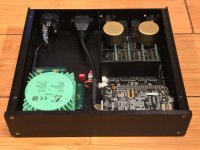Attachments
R3??10K:10K???????????????????????-???
or
R3 Jiayin 10K:10K permalloy audio transformer pre input cattle single end turn to balance signal isolation-in Transformers from Home Improvement on Aliexpress.com | Alibaba Group
Shield on transformers are optional. Enough steel shield between the power transformer and the analog part of the DSC2.
or
R3 Jiayin 10K:10K permalloy audio transformer pre input cattle single end turn to balance signal isolation-in Transformers from Home Improvement on Aliexpress.com | Alibaba Group
Shield on transformers are optional. Enough steel shield between the power transformer and the analog part of the DSC2.
Last edited:
The difference in sound between melf and tantalum is not big.
.
MELF is not the type of resistors, is just a case type, usually used when the resistor expect pulse current instead of continuos, and there is no one other advantage.
Resistor in the MELF package can be even carbon(!), which is not suitable for audio at all.
(except for esoteric use case)
I wrote about a specific model of resistors Vishay melf MMA0204 0,1%Vishay melf MMA0204 0.1% have a darker....
You miss the word "this" in the statement:
"The difference in sound between <this> melf and tantalum is not big".
without this word, the statement has a completely different meaning.
"The difference in sound between <this> melf and tantalum is not big".
without this word, the statement has a completely different meaning.
R3??10K:10K???????????????????????-???
or
R3 Jiayin 10K:10K permalloy audio transformer pre input cattle single end turn to balance signal isolation-in Transformers from Home Improvement on Aliexpress.com | Alibaba Group
Shield on transformers are optional. Enough steel shield between the power transformer and the analog part of the DSC2.
Where did you bought the shield?
You miss the word "this" in the statement:
"The difference in sound between <this> melf and tantalum is not big".
without this word, the statement has a completely different meaning.
c'mon Alex, everybody understood, what was meant 🙂 in contrast the aliexpress link to those nice trafos had an unforgettable description indeed:
"... аудио трансформатор предварительно ввода крупного рогатого скота одного конца..."
so, nobody is perfect, even google translate. sorry for this OT, but the Russian sentence suggests, there will be "preliminary entering of a bunch of cows from one side.. OMG!
In Russian, this phrase sounds no less absurd.😀
It was an automatic translation from Chinese to Russian.
It was an automatic translation from Chinese to Russian.
No.
It was automatic translation from Chinese to English, at first.
After that - automatic translation from English to Russian 🙂
It was automatic translation from Chinese to English, at first.
After that - automatic translation from English to Russian 🙂
I just finished building a DSC2 board.
I was experiencing noise in the left channel; after investigating I found that touching the clock lines (outputs of U11 and U22) with a finger or an oscilloscope probe, I could make the noise disappear in the noisy channel or appear in che clean channel. I added 4x 220R terminations to ground across pins 8-11 of U15, U19, U26, U30 (74AHCT595), that is at the end of the 4 clock tracks. The problem disappeared and the board is not sensitive anymore to external contact on these tracks.
I was experiencing noise in the left channel; after investigating I found that touching the clock lines (outputs of U11 and U22) with a finger or an oscilloscope probe, I could make the noise disappear in the noisy channel or appear in che clean channel. I added 4x 220R terminations to ground across pins 8-11 of U15, U19, U26, U30 (74AHCT595), that is at the end of the 4 clock tracks. The problem disappeared and the board is not sensitive anymore to external contact on these tracks.
Hmm ... This problem used to be when using only Xmos and DSC2.5-2.6 versions.
The fact is that the Xmos MCLK phase is slightly different from Amanero. And apparently the registers AHCT595 were in a metastable state.
You also slightly shifted the MCLK phase with resistors.
The fact is that the Xmos MCLK phase is slightly different from Amanero. And apparently the registers AHCT595 were in a metastable state.
You also slightly shifted the MCLK phase with resistors.
Attachments
It seems to me that in my case it was a simple problem of reflection along the clock line.
The sensitivity to external contact on the trace was almost zero at the output of U11/U22, while it was very high close to the last 595's of the line (U15, U19, U26, U30).
Do you think the phase shift could be a problem?
The sensitivity to external contact on the trace was almost zero at the output of U11/U22, while it was very high close to the last 595's of the line (U15, U19, U26, U30).
Do you think the phase shift could be a problem?
- Home
- Source & Line
- Digital Line Level
- Signalyst DSC1

